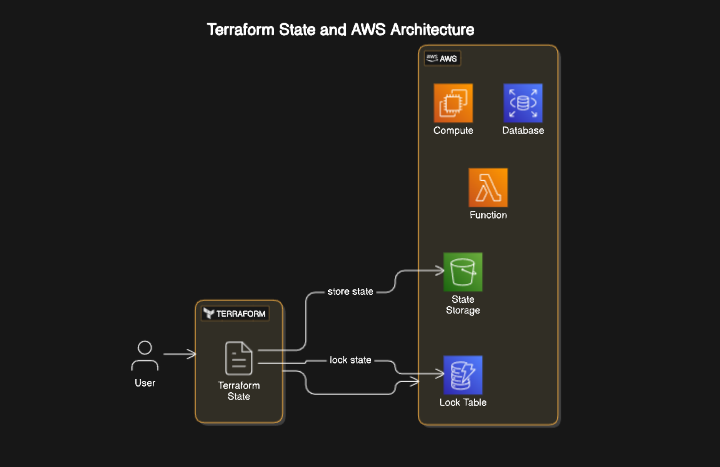☑️Day 67: Terraform State & Starting with AWS🚀
 Kedar Pattanshetti
Kedar Pattanshetti
🔹Table of Contents :
Introduction
Setting Up Terraform with AWS
Creating an AWS IAM User for Terraform
Using Terraform Commands with AWS
Key Takeaways
In today’s DevOps journey, I explored how Terraform manages state and performed hands-on work integrating Terraform with AWS to begin provisioning cloud resources. I’ll go through each step, from setting up the AWS CLI to using Terraform commands with AWS resources, and wrap up with some real-world applications.
✅1. Introduction to Terraform State
Terraform’s state file (.tfstate) is a crucial part of managing infrastructure, as it keeps track of resources already provisioned. Here’s a breakdown:
Commands:
terraform initInitializes the project and installs necessary providers.
terraform planPreviews changes to be applied, without actually making changes.
terraform applyProvisions resources as specified in
.tffiles.
What’s Included in
.tfstate:Resource types and settings.
Provider configurations.
Metadata about each resource's configuration.
Real-World Scenario: With
.tfstate, Terraform can track whether an S3 bucket or EC2 instance exists, helping avoid redundant creation.
✅2. Setting Up Terraform with AWS
The AWS CLI is necessary for managing AWS resources directly from the command line, which integrates seamlessly with Terraform. Here are the setup steps I followed:
✅AWS CLI Installation
Create a Project Directory:
mkdir terraform-aws cd terraform-awsInstall AWS CLI:
sudo apt update sudo apt install awscli -yVerify Installation:
aws --versionList AWS S3 Buckets (to test connection):
aws s3 lsConfigure AWS CLI:
aws configureEnter your
AWS Access Key,Secret Access Key,Region, and preferredOutput format. This step sets up AWS CLI to communicate with Terraform.
Real-World Scenario: AWS CLI configuration allows you to manage and automate cloud resources efficiently, enabling you to deploy and scale resources faster, especially useful in multi-region setups.
✅3. Creating an AWS IAM User for Terraform
AWS Identity and Access Management (IAM) provides secure access control. Creating a dedicated IAM user for Terraform helps keep permissions organized and ensures security.
✅Steps to Create an IAM User:
Log into AWS Console and navigate to IAM.
Create a New User:
Go to Users > Add User.
Name the user (e.g.,
terraform_user).Set Access Type to
Programmatic access.
Attach Policies:
- Add
AdministratorAccess(or custom policies based on permissions needed).
- Add
Store Credentials: Download the
.csvfile with the access and secret keys, which will be used inaws configure.
Real-World Scenario: By using a dedicated IAM user, you can isolate and audit Terraform operations, ensuring that all infrastructure changes are secure and trackable.
✅4. Using Terraform Commands with AWS
Now that the AWS CLI is set up, I created a simple Terraform configuration file (main.tf) to start defining and deploying AWS resources.
Writing main.tf for AWS Resources
Below is an example configuration that sets up an S3 bucket and an EC2 instance.
provider "aws" {
region = "us-east-1"
}
resource "aws_s3_bucket" "my_bucket" {
bucket = "my-terraform-bucket-unique-id"
acl = "private"
}
resource "aws_instance" "my_ec2_instance" {
ami = "ami-0c55b159cbfafe1f0" # Example Ubuntu AMI
instance_type = "t2.micro"
}
✅Running Terraform Commands
Initialize the Project:
terraform initThis downloads necessary providers and plugins for AWS.
Preview Changes:
terraform planShows what will be created in AWS before making actual changes.
Apply Configuration:
terraform applyApplies the configuration and provisions the resources defined in
main.tf.View Terraform State:
terraform showProvides details of the current state, showing the resources Terraform manages.
List State Resources:
terraform state listLists all resources currently tracked by Terraform’s state file.
Verify in AWS: Go to the AWS Console and check if the S3 bucket and EC2 instance are created as specified.
Real-World Scenario: Using Terraform with AWS, you can automate the creation and scaling of resources. This approach is particularly useful for quickly setting up environments for testing, scaling production resources, or creating infrastructure templates.
✅5. Key Takeaways
Terraform State: Tracks resources, prevents duplicate creation, and provides current configuration details.
AWS CLI and IAM: Configures Terraform to interact securely with AWS services.
Terraform Commands with AWS: Easily manage infrastructure lifecycle through commands like
init,plan, andapply.
Real-World Application: With Terraform and AWS, infrastructure can be version-controlled and replicated across multiple environments (development, testing, production) with minimal manual effort, supporting rapid deployment and scalability.
Stay tuned for more hands-on tasks and in-depth learning!🚀
🚀Thanks for joining me on Day 67! Let’s keep learning and growing together!
Happy Learning! 😊
#90DaysOfDevOps
Subscribe to my newsletter
Read articles from Kedar Pattanshetti directly inside your inbox. Subscribe to the newsletter, and don't miss out.
Written by
